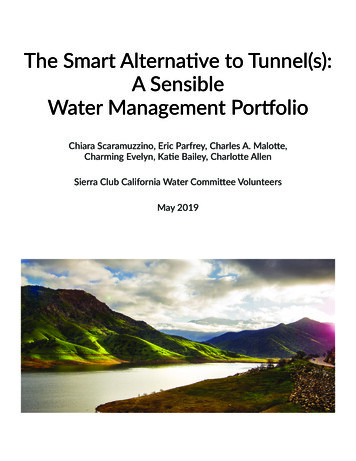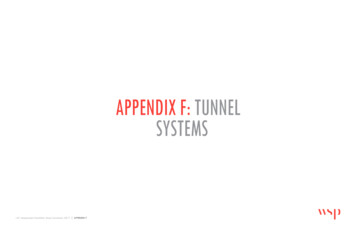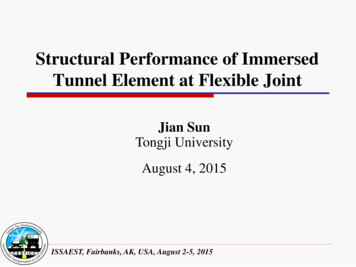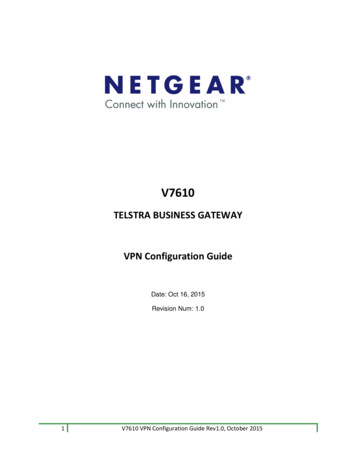
Transcription
The Smart Alternative to Tunnel(s):A SensibleWater Management PortfolioChiara Scaramuzzino, Eric Parfrey, Charles A. Malotte,Charming Evelyn, Katie Bailey, Charlotte AllenSierra Club California Water Committee VolunteersMay 2019
Photo by Bob Wick, Bureau of Land Management
The Smart Alternative to Tunnel(s): A Sensible Water Management PortfolioSince passage of legislation in 2009, California’s water policy debate has been dominated by the controversy over GovernorBrown’s proposal to build two 40-foot diameter, 30-mile long tunnels that would divert water from the Sacramento Riveraround the San Francisco Bay Delta for export to the south.1 More recently, Governor Newsom has rejected the two tunnelsplan and suggested they be replaced by a single tunnel.What California needs is not two tunnels, or one tunnel. What it needs is a diverse water portfolio, including firm commitmentsof water for the environment. California can meet its water needs and provide the flows needed to restore the Delta with acombination of increased agricultural and urban conservation, groundwater storage and management, increased water reuse,and stormwater capture. A smart and sustainable water portfolio will enable us to meet the challenges of climate change andprovide the water our families, farms, and ecosystems require to flourish.The amount of water we could save in California with this combination of conservation measures is enough to stop the overdraft of California’s groundwater basins and replace much if not most of the water we now take from the Delta, thus restoringthe ecological health of the Delta and making even one tunnel unnecessary.Potential Water Savings/Supplies from a Portfolio of Resilient StrategiesResource StrategyWater Savings/Supplies (million acre-feet/year)Agricultural Water Use Efficiency5.6 - 6.6 MAFUrban Water Use Efficiency2.9 - 5.2 MAF2Recycled Municipal Water1.2 - 1.8 MAF3Stormwater Capture0.4 - 0.6 MAFGroundwater Storage and Conjunctive Use0.5 - 2.0 MAFTOTAL10.6 - 16.2 MAFThis table has been compiled from 2014 analysis by the Pacific Institute and Natural Resources Defense Council,4 and 2016analysis by the Department of Water Resources.5 The Sierra Club opposes the more aggressive operation of reservoirs and theDelta pumping plants DWR proposes in order to achieve maximum gains from conjunctive groundwater storage as we believethese gains can be achieved using more sustainable and environmentally-friendly techniques.A History of the Delta TunnelsThe California tunnels project, now referred to by its proponents as the “WaterFix”, was previously called the Bay Delta Conservation Plan (BDCP). The Department of Water Resources held the first meeting to discuss the BDCP in May of 2006,6 twomonths after the Emergency Petition to declare the Delta Smelt an endangered species was filed.7 The BDCP was proposed asa comprehensive Habitat Conservation Plan for the Delta which would address the collapse of endangered fish populations.1. Special thanks to California Water Research for contributing to this report.2. About 2.1 MAF of Pacific Institute’s projections of potential urban water conservation savings were realized in 2015. The Untapped Potential of California’sWater Supply used the average of urban uses between 2001 and 2010 as a baseline, which was 9.1 MAF a year. According to the 2018 California Water PlanUpdate, in 2015, urban uses consumed an average of 7.0 MAF a year (p. 1-5.) Available at Draft.pdf.3. Even greater supplies could be realized if SB 332 is enacted -- estimates are 2.5 MAF.4. Peter Gleick et. al. The Untapped Potential of California’s Water Supply: Efficiency, Reuse, and Stormwater. Pacific Institute and Natural Resources DefenseCouncil, June 2014. Available at water-capstone.pdf.5. California Department of Water Resources, Conjunctive Management and Groundwater, A Resource Management Strategy of the California Water Plan, July2016. Available at http://www.water.ca.gov/waterplan/docs/rms/2016/08 ConjMgt GW Storage July2016.pdf.6. Bay Delta Conservation Plan Steering Committee. Agenda, May 19, 2016. Available at mic Document Library - Archived/5 19 06 agenda.sflb.ashx.7. Center for Biological Diversity, The Bay Institute, and Natural Resources Defense Council. “Emergency Petition to List the Delta Smelt (Hypomesustranspacificus) as an Endangered Species Under the Endangered Species Act,” March 8, 2006. Available at ion-3-8-06.pdf.Sierra Club California Water Committee2
By November 2007, the steering committee, which included DWR, the Federal Bureau of Reclamation, water agencies, fisheryagencies, the California Farm Bureau, and some environmental groups, had agreed on “a dual conveyance system, the ultimateacceptability of which will turn on important design, operational and institutional arrangements that the Steering Committeewill develop and evaluate through the planning process.”8In 2009, the Delta Reform Act, which enacted the BDCP planning process into law, came before the legislature. Sierra Cluband other environmental organizations, as well as Delta stakeholders, strongly opposed the legislation. The legislation passed,and the environmentalists’ worst fears were soon realized. By 2010, the BDCP steering committee had proposed an enormousnew conveyance, with five 3,000 cubic feet per second intakes in the North Delta, which would feed two 33-foot diameterpressurized tunnels. A draft Environmental Impact Report / Environmental Impact Statement was circulated in 2013. Environmental organizations that had initially supported the project protested the new two tunnels design.9 In 2015, the project waschanged to two 40-foot gravity flow tunnels, the number of intakes was reduced to three, and the tunnel alignment was movedto the east. The extensive federal Habitat Conservation Plan component of the project was dropped, and the remaining habitatrestoration program10 was rebranded as EcoRestore.11The following sections present our portfolio alternative to the tunnels—increased agricultural and urban conservation,groundwater storage and management, increased water reuse, and stormwater capture.Agricultural Water ConservationWater conservation in agriculture is crucial to reducing water consumption in California since agricultural water use representsabout 80% of total annual human water use.12 To avoid further diversions of water from the Bay Delta and its watersheds, newmanagement systems and investment are required. Thanks to improved irrigation techniques, agricultural water use efficiencyincreased for most crops in California between 2001 and 2010, according to estimates by the UC Davis Water ManagementResearch Laboratory.13 Even though water efficiency has increased, water savings are still being directed towards agriculturalproduction and more needs to be done to return them to the environment instead.8. Bay Delta Conservation Plan Steering Committee. “The Bay Delta Conservation Plan: Points of Agreement for Continuing into the Planning Process,”Draft, November 16, 2017. Available at mic Document Library - Archived/11 16 07 HO BDCPPoints of Agreement.sflb.ashx.9. John Cain et. al., “NGO letter to Messr.s Laird, Hayes, Meral and Connor,” September 30, 2011. Available at sources-agency-david-hayes.10. CALFED Bay Delta Program, Programmatic Record of Decision, August 28, 2000. Available at 2800.pdf.11. Acreage cited in comments by Local Agencies of the North Delta on the 2018 Draft California Water Action Plan Update. Available at .pdf.In contrast to the 100,000 acres proposed to be restored by BDCP, EcoRestore is currently implementing only the minimum habitat restoration projectsrequired as mitigation for the impacts of the Central Valley Project and State Water Project under the federal Endangered Species Act Section 7 permits.The 2008 and 2009 Biological Opinions required up to 28,000 acres of tidal and floodplain habitat restoration Biologists overseeing the habitat restorationprojects say the benefits are uncertain.12. Jeff Mount and Ellen Hanak. “Just the Facts: Water Use in California,” Public Policy Institute of California, July 2016. Available at https://www.ppic.org/content/pubs/jtf/JTF WaterUseJTF.pdf.13. Samuel Sandoval-Solis, Ph.D., et. al. Spatial Analysis of Application Efficiencies in Irrigation for the State of California Water Management Research Laboratory, UC Davis, June 2013. Available at Solis%20et%20al%202013%20-%20Report.pdf.Sierra Club California Water Committee3
Increase irrigation efficiency. Flood and furrow remain the predominant irrigation methods, accounting for 43% of all irrigatedacres.14 However, adoption of drip and micro-irrigation systems has been spreading rapidly, accounting for 39% of irrigatedacres. This shift can be attributed partly to federal assistance mechanisms – farmers can benefit from a 50% discount on dripirrigation systems – and partly to the higher efficiency of new irrigation systems. Using these systems can result in increases inefficiency of applied water, from 10% to 20% or more.15,16 But the impacts on local groundwater basins must be carefully evaluated before implementing high-efficiency irrigation systems, as they can have detrimental impacts on groundwater rechargeand result in greater overall water use.17Employ soil management and crop selection. The Pacific Institute identifies irrigation technology, irrigation scheduling and regulated deficit irrigation for specific crops as the main water-saving practices in agriculture.18 However, soil management techniques such as mulching, rotational grazing, cover crops integration, and conservation tillage19,20 not only provide significantwater savings due to reduced evaporation, they also sequester and store carbon in the soil. Selecting water-efficient crops inarid regions over water-intensive ones is also important as evapotranspiration rates increase due to climate change.Upgrade agricultural water district infrastructure. To boost water savings, capital investments need to be directed towardsupgrading the infrastructure of agricultural water districts. In a district like the Oakdale Irrigation District, in which annualwater losses amount to 100,000 acre-feet per year (afy), with 45-55% of these coming from on-farm losses, reducing waterspills by 75% could save 15,000 afy of water.21Shift land uses. Another way to increase water efficiency in agriculture would be reclaiming and retiring degraded lands on thewestern side of the San Joaquin Valley to repurpose them for more sustainable uses. Partial or complete fallowing of degradedfields holds a high potential for water conservation. A comprehensive study in 1990 projected a total of 1,000,000 drainageimpaired acres of land on the western side of the San Joaquin Valley by 2000.22 Drainage impaired land has been going out ofproduction. Westlands Water District reported 89,000 acres of retired land in 2006.23 The Department of Land Conservation’s most recent report found a further net reduction of 276,000 irrigated acres of land in the San Joaquin Valley between2006 and 2012.24 A consortium of entities could consider buying more drainage-impaired acres of land – and associated waterrights. Given its location, adjacent to major interties to the state electrical grid, the land could be used for the development ofsolar farms.Assess and manage water transfers. Further legislative efforts should be made to establish and enforce rules and regulationsaimed at assessing the environmental and economic impacts of water transfers. Transfers of water from one agricultural district to another (for example from Sacramento Valley to San Joaquin Valley) particularly deserve scrutiny during drought periods, while transfers from agricultural districts to urban agencies should be consistent with regional plans.14. Renee Johnson and Betsy Cody, California Agricultural Production and Irrigated Water Use, Congressional Research Service, June 30, 2015. Available athttps://fas.org/sgp/crs/misc/R44093.pdf.15. Samuel Sandoval-Solis, Ph.D., et. al. Op. cit.16. United States Environmental Protection Agency, Water Efficiency Management Guide Landscaping and Irrigation, November 2017. Available igation-landscape-guide.pdf.17. Irrigation Study.pdf.18. Heather Cooley et. al., Agricultural Water Conservation and Efficiency Potential in California, Pacific Institute and Natural Resources Defense Council, June2014. Available at supply-solutions-ag-efficiency-IB.pdf.19. Jeffrey P. Mitchell et. al., “No-tillage and high-residue practices reduce soil water evaporation,” California Agriculture 66(2):55-61. Available athttps://doi.org/10.3733/ca.v066n02p55.20. D.G. Sullivan et. al., “Potential impact of conservation tillage on conserving water resources in Georgia,” Journal of Soil and Water Conservation, May/June2007 vol. 62 no. 3 145-152. Available at t.21. Deanna Wulff, “California’s Choices: Two Big Expensive Tunnels or Just Better Water Management,” Bilingual Weekly, March 6, 2012. Available just-better-water-management.22. A Management Plan for Agricultural Subsurface Drainage and Related Problems on the Westside San Joaquin Valley : Final Report of the San Joaquin Valley Drainage Program. U.S. Department of the Interior and California Natural Resources Agency, 1990. Available at 23. Tom Birmingham, Testimony before the House Committee on Natural Resources, Subcommittee on Water and Power, September 21, 2006.24. California Department of Conservation, Division of Land Resource Protection, California Farmland Conversion Report, 2015, p. 24. Available nts/fmmp/pubs/2010-2012/FCR/FCR%202015 complete.pdf.Sierra Club California Water Committee4
Urban Water ConservationThe least expensive, least energy-intensive, and most environmentally prudent way to meet California’s future urban waterneeds is through conservation and public education. With existingtechnology as well as new landscaping, plumbing, metering, andgreen building ordinances, the potential for water savings in urbanareas has increased over the years. The Pacific Institute statesthat with current technology only, California has the means tosave between 2.9 and 5.2 million afy through urban conservation.25 And at least 85% of these savings would be cheaper thantapping into new sources of supply.26Limit landscaping water use. On average, outdoor water use accounts for about half of the water consumed in urban areas inthe state.27 In areas such as Los Angeles, that amount increases to around 70%. Since most water use occurs outdoors, thepotential for greater water conservation must happen there. Water agencies should promote the use of soil-moisture basedirrigation systems as well as regionally appropriate native plants. In July 2015, California’s governor signed The ModelEfficient Landscape Ordinance (MWELO) into law to reduce water use for new landscaping projects with more than 500square feet of irrigated area, as well as landscape renovations greater than 2,500 square feet. Implementation of the newlaws have been left to county and local government agencies and enforcement varies throughout the state. The legislatureshould revisit the existing program and determine if changes are required to ensure it applies to all areas of the state and itreaches the maximum water savings.Capture rainwater. Rainwater capture reduces the reliance on potable water for landscaping needs and provides a rechargebenefit to underlying groundwater aquifers. While legislation has made it easier and more cost effective to increase rainwatercapture,28 more needs to be done to encourage and help homeowners install rainwater capture systems. Collecting the firstquarter inch of rain from a 1,000 square foot roof can produce as many as 150 gallons. If all of the approximately 3.5 millionhousing units in Los Angeles were to install just one single rain barrel, the city could save approximately 590 afy of water.Reuse greywater. Greywater is primarily the byproduct of household water used for washing. This includes water from sinks,showers, bathtubs, and washing machines. With a greywater system, homeowners could reuse up to 80% of this water toirrigate plants and trees within their property, saving up to 50,000 gallons a year.29 While the permitting process for greywaterhas been streamlined, interpretation of the codes is often left to individual inspectors. Continued education and resourcescould lead to greater implementation and water savings.Fix aging infrastructure. A 2011 report from the California Public Utilities Commission estimated that 10% of all urban waterdeliveries are lost to leaks every year.30 Pipes that deliver drinking water are rusting, clogging, and cracking, and reservoirs arelosing storage capacity. Our nation’s water systems lose almost 7 million afy of treated water due to problems such as leakingpipes.31 In Los Angeles alone, water officials estimate that almost 25 thousand afy of water is lost to leaky pipes, firefighting,evaporation, theft and other unaccounted losses.32 Irrespective of any other plans to gather or deliver water, repairs of ouraging water infrastructure will need to be completed if California plans to meet its responsibility to provide safe, clean waterto all its citizens, and ensure the human right to water.25. Matthew Heberger et. al., Urban Water Conservation and Efficiency Potential in California, Pacific Institute, June 2014, p. 2. Available at water-urban.pdf.26. Peter Gleick, et. al., Waste Not Want Not, Pacific Institute, November 2003. Available at https://pacinst.org/reports/urban usage/waste not want notfull report.pdf.27. Ibid.28. In 2012, the Rainwater Recapture Act allowed residential users, and other private and public entities, to capture and use rainwater harvested from rooftops. In 2018, California Proposition 72 allowed Rainwater Capture systems to be added to the value of the home yet be excluded from property tax assessments.29. Lucy Allen, Juliet Christian-Smith, and Meena Palaniappan, Overview of Greywater Reuse: The Potential of Greywater Systems to Aid Sustainable Water Management, The Pacific Institute, November 2010. Available at /2013/02/greywater overview3.pdf.30. Cited by Paul Rogers in “California drought: Leaky water pipes losing billions of gallons targeted by new state law,” San Jose Mercury News, October 9, 2015.31. American Society of Civil Engineers, 2017 Infrastructure Report Card. Available at drinking water.32. Ben Poston and Matt Steven, “L.A.’s aging water pipes; a 1-billion dilemma,” Los Angeles Times, February 6, 2015. Available at ructure.Sierra Club California Water Committee5
Desalinate brackish groundwater. The opportunities are great for providing water supply from brackish groundwater desalination as well as recovering contaminated groundwater. Brackish water desalination can be used to help relieve drought conditions, replace water lost from other sources, and replace water that can be used for river and stream ecosystem restoration.Although most estimate that brackish groundwater desalination will contribute less than 10% of the total water supply needsin California, this still represents a significant portion of the state’s water supply portfolio. Currently, there are 24 inland brackish water desalination plants in California and an additional 17 in the planning stages.33 Additional focus should be placed onbrackish water desalination as it is generally cheaper and much less energy intensive than ocean water desalination.Water ReuseWater reclamation and reuse have long been an essential but underutilized part of California’s water policy, and the Stateshould continue to expand its efforts to reuse municipal wastewater to meet the demand for water supply.The 2019 proposed amendment to the State’s Recycled Water Policy aims to “increase the use of recycled water.to 1.5 millionafy by 2020 and to 2.5 million afy by 2030.”34 In 2015 the amount of recycled water used in the state was 714,000 afy, up fromroughly 500,000 afy in 2013. This increase is significant but still well below the reuse potential.Southern California is home to the state’s more prominent reuse initiatives, but there are significant opportunities for advancement in the region. Orange County’s Groundwater Replenishment System (OCGRS) is one of the largest purification systemsfor indirect potable reuse in the world and produced 100,363 afy of indirect potable water in 2017.35 Sanitation Districts ofLos Angeles County (SDLAC) has 11 facilities that recycle water, and during the 2015-2016 fiscal year, SDLAC reused 100,698afy, or roughly 67.3% of the recycled water they produced.36 Additionally, the Inland Empire and San Diego County utilizevarious programs to introduce recycled water into their water supplies. However, these programs often aren’t using all of thereclaimed water they produce and are also recycling water at a rate well below their maximum capacity. By investing in theinfrastructure to maximize the amount of recycled water generated and reused we can increase the water supply significantly.At SDLAC alone, maximizing recycled and reuse capacities would increase the water supply by close to 130,000 afy37, basedon 2015-2016 fiscal year levels. Furthermore, by directing funding to expand reuse programs across the state, we can ensurethat local regions are protecting themselves against changes to our water supply and consumer demand and reduce the needto rely on imported water from the San Francisco Bay Delta without a tunnel system.33. Heather Cooley and Rapichan Phurisamban, The Cost of Alternative Water Supply Efficiency Options, Pacific Institute, October 13, 2016. Available at ater-supply-efficiency-options-california.34. State Water Resources Control Board, Water Quality Control Policy for Recycled Water, 2018. Available at https://www.waterboards.ca.gov/water issues/programs/water recycling policy/docs/2018/121118 7 final amendment.pdf.35. Orange County Water District, Groundwater Replenishment System, 2017 Annual Report. Available at eport.pdf.36. Sanitation Districts of Los Angeles County, 27th Annual Status Report on Recycled Water Use, 2015-16. Available at blobid 14586.37. Calculation: 149,719 afy of recycled water produced by SDLAC in 15-16FY equaled 53.3% of recycled water capacity. 149,719/.533 280,898.687 (maximum capacity) difference between the two is 131,179 afy.Sierra Club California Water Committee6
Managing Groundwater SustainablyAs noted in the Delta Plan, more than 40% of Californians rely on groundwater for part of their water supply, and many smallto moderate-size towns and cities are entirely dependent on groundwater for their drinking water systems. The state’s mostsignificant groundwater use occurs in regions that also rely on water from the Delta watershed, including the San JoaquinValley, Tulare Lake, Sacramento Valley, Central Coast, and South Coast. The Tulare Lake region alone, in the southern SanJoaquin Valley, accounts for more than one-third of the state’s total groundwater pumping, according to the Department ofWater Resources.38Because of historical groundwater overdraft and resulting land subsidence experienced in these regions, water usersswitched to using surface water when the Central Valley Project and the State Water Project were completed in the late1960s. However, groundwater pumping and overdraft became more severe as water demands exceeded available supplies.Satellite imaging published by Jay Famiglietti, of the University of California Center for Hydrologic Modeling, and othersreveals that the Central Valley lost approximately 25 million acre-feet of stored groundwater during the period of October2003 to March 2010.39California was one of the last states in the nation to regulate groundwater. Governor Jerry Brown signed major new groundwater management legislation, the Sustainable Groundwater Management Act (SGMA) in September 2014. For the first timein its history, California has a framework for sustainable, groundwater management - “management and use of groundwater ina manner that can be maintained during the planning and implementation horizon without causing undesirable results.” SGMAempowers local agencies to form Groundwater Sustainability Agencies (GSAs) to manage basins sustainably and requiresthose GSAs to adopt Groundwater Sustainability Plans for crucial groundwater basins in California.SGMA requires governments and water agencies of high and medium priority basins to halt overdraft and bring groundwater basins into balanced levels of pumping and recharge. However, the timelines for reaching this new sustainability stretchvery far into the future. Under SGMA, the most overdrafted basins should reach sustainability within 20 years of implementing their sustainability plans. For critically overdrafted basins, that will be 2040. For the remaining high and medium prioritybasins, 2042 is the deadline. The amount of groundwater that is at risk, and could be used more efficiently, is huge. Althoughthe Bay Delta is a major source of water supply for California (approximately five million afy), the Bay Delta supply is less thanthe amount of groundwater that is pumped by farmers (approximately eight million afy). The State Water Board estimatesthat more than 30% of California’s water for agriculture and urban use is pulled from the ground and reliance on groundwaterincreases to 40% during dry years when surface water supplies shrink.We have a crisis building in the state. Groundwater reserves that could be a critically needed resource in times of drought forboth farms and urban customers are shrinking. DWR reports that groundwater is being depleted at a rate of 2 million afy,40though some estimates taking a shorter time period (October 2003 through March 2009) into account put the depletion ratemuch higher, as high as 4.4 million afy.41 The problem is especially critical in the San Joaquin Valley. It is estimated that groundwater reserves are shrinking by 2.5 million afy in the Central Valley. “That is enough water to supply the needs of nearly 22 million people each year,” Famiglietti told the Modesto Bee in November 2013.42 “People need to truly understand groundwateris disappearing Without intervening, that water is not coming back.”38. Delta Stewardship Council, Delta Plan, adopted May, 2013. Available at http://deltacouncil.ca.gov/delta-plan-0.39. J.S. Famiglietti et al, “Satellites Measure Recent Rates of Groundwater Depletion in California’s Central Valley”, Geophysical Research Letters, February 2011. Available at https://www.researchgate.net/publication/237998500 Satellites Measure Recent Rates of Groundwater Depletion in California%27s Central Valley.40. California Department of Water Resources, California Water Plan Update 2013, available at .pdf.41. Peter Gleick, Stealing Water from the Future – California’s Massive Groundwater Overdraft Newly Revealed, Circle of Blue Water News, December 16, 2009,available at ive-groundwater-overdraft-newly-revealed.42. J.N. Sbranti, “Groundwater levels falling at alarming rate while lawmakers decide what to do,” Modesto Bee, November 9, 2013. Available ndwater-crisis/article3156438.html.Sierra Club California Water Committee7
One of the predictions about climate change is that California will get more rain overall, but this rain will be less evenly distributed over time.43 More intense storms and big rainfall years, and longer and more severe droughts. We’re already beginning to see this change - one of the worst California droughts and its four biggest rainfall years post-1900 have all occurredsince 1980.44 Our water management and water use will have to change in response. A key change will be the restoration ofour groundwater reserves, which are the largest reservoirs by far in California, provide crucial supplies in drought, and are aday-to-day water source for many, especially in disadvantaged Central Valley communities. To do this, we must accelerate theimplementation of SGMA and aim for an increase in the current levels of groundwater, not just the avoidance of undesirableresult
The Smart Alternative to Tunnel(s): A Sensible Water Management Portfolio Since passage of legislation in 2009, California's water policy debate has been dominated by the controversy over Governor Brown's proposal to build two 40-foot diameter, 30-mile long tunnels that would divert water from the Sacramento River










